Time limit: 0
Quiz Summary
0 of 36 Questions completed
Questions:
Information
You have already completed the quiz before. Hence you can not start it again.
Quiz is loading…
You must sign in or sign up to start the quiz.
You must first complete the following:
Results
Quiz complete. Results are being recorded.
Results
0 of 36 Questions answered correctly
Your time:
Time has elapsed
You have reached 0 of 0 point(s), (0)
Earned Point(s): 0 of 0, (0)
0 Essay(s) Pending (Possible Point(s): 0)
Categories
- Not categorized 0%
- NBME 7 BLOCK 4 0%
- 1
- 2
- 3
- 4
- 5
- 6
- 7
- 8
- 9
- 10
- 11
- 12
- 13
- 14
- 15
- 16
- 17
- 18
- 19
- 20
- 21
- 22
- 23
- 24
- 25
- 26
- 27
- 28
- 29
- 30
- 31
- 32
- 33
- 34
- 35
- 36
- Current
- Review
- Answered
- Correct
- Incorrect
-
Question 1 of 36
1. Question
A 35-year-old woman comes to the office due to fever, headache, severe muscle aches, and sore throat for the last 4 days. Physical examination shows mild pharyngeal erythema and nasal congestion. A rapid influenza antigen test is positive. The patient’s condition improves over the next several days despite receiving only symptomatic treatment. In response to the influenza virus, infected respiratory epithelial cells begin secreting increased quantities of interferons. The specific interferons secreted by these cells will most likely cause which of the following changes?
CorrectIncorrect -
Question 2 of 36
2. Question
A 19-year-old man comes to the office due to a painful subcutaneous forearm nodule. Two weeks earlier, he received a laceration on his left forearm while playing soccer and had sutures placed. The lesion is biopsied, and results are shown in the image below:

Which of the following is most likely responsible for this patient’s condition?
CorrectIncorrect -
Question 3 of 36
3. Question
A 15-year-old girl is evaluated due to persistent fever, fatigue, and sore throat. Physical examination reveals splenomegaly and symmetric posterior cervical lymphadenopathy. Peripheral blood smear results are shown in the image below:

The atypical cells seen here are most likely an activated form of which of the following?
CorrectIncorrect -
Question 4 of 36
4. Question
A 24-year-old man comes to the office due to paroxysmal episodes of breathlessness and wheezing for the past 6 months. He does not recognize any triggers for these episodes and reports they are not associated with exercise or stress. The patient has no history of recent illness. He had eczema as a child. The patient has no other medical conditions and takes no medications. Vital signs are within normal limits. Lung examination shows good air movement and no wheezing. Sputum microscopy reveals many granule-containing cells and crystalloid masses. The sputum findings in this patient are a direct result of which of the following cytokines?
CorrectIncorrect -
Question 5 of 36
5. Question
A 22-year-old woman comes to the office due to 2 weeks of profound fatigue, which has prevented her from attending college classes. The fatigue was preceded by fevers and sore throat, but these have now improved. The patient is an exchange student from Turkey and has no prior medical conditions. She does not use tobacco, alcohol, or illicit drugs. Vital signs are within normal limits. Oropharyngeal examination shows no abnormalities. There are several enlarged lymph nodes posterior to the sternocleidomastoid muscle bilaterally. Cardiopulmonary examination is unremarkable. The spleen is palpable 1 cm below the left costal margin. No skin rashes or other lymphadenopathy is present. Peripheral blood evaluation shows increased numbers of abnormal white blood cells as shown in the exhibit. The observed cytoplasmic granules of these cells are most likely to contain which of the following substances?
 CorrectIncorrect
CorrectIncorrect -
Question 6 of 36
6. Question
A 65-year-old man comes to the office due to shortness of breath, weakness, and cough for 1 week. He underwent bilateral lung transplantation for idiopathic pulmonary fibrosis 3 months ago. Temperature is 38.3 C (101 F), blood pressure is 130/80 mm Hg, pulse is 90/min, and respirations are 18/min. Chest x-ray shows perihilar opacities and interstitial edema. Transbronchial biopsies reveal moderate perivascular and peribronchiolar mononuclear infiltrate predominantly composed of lymphocytes. No viral inclusions are present. Which of the following is the most likely diagnosis?
CorrectIncorrect -
Question 7 of 36
7. Question
A 6-year-old girl is brought to the clinic due to an itchy rash on her face. The patient’s mother says the rash began approximately 3 weeks ago as dry skin on both of her cheeks. Over the past few days, it has progressed with areas of weeping and increased redness, and the patient has had to wear mittens to limit irritation from constant scratching. The patient has a history of similar rashs involving the flexural areas of her elbows and knees that resolved following treatment with topical corticosteroids. Vital signs are normal. Physical examination shows erythema of the bilateral cheeks and chin with crusting and oozing. The patient is prescribed a course of topical tacrolimus. Which of the following is the most likely mechanism of action of this drug?
CorrectIncorrect -
Question 8 of 36
8. Question
A clinical trial is being conducted to evaluate the safety and efficacy of a novel therapy to treat refractory Crohn disease. The medication is a monoclonal antibody against the α4β7 integrin, which inhibits migration of T-lymphocytes into the intestinal parenchyma and produces a gut-selective anti-inflammatory effect. Patients who have active, moderate to severe Crohn disease and have failed conventional therapy are enrolled in the study. Many of these patients have renal or hepatic dysfunction, and some take other medications that affect cytochrome P450 enzymes. Which of the following is the most appropriate dose adjustment in this patient population to decrease drug toxicity?
CorrectIncorrect -
Question 9 of 36
9. Question
A 62-year-old woman is admitted to the hospital for a living-donor kidney transplant. She has a history of end-stage kidney disease due to diabetic nephropathy and has been undergoing hemodialysis for the last 2 years. The transplant surgery is performed without complication, and the patient demonstrates good urine output afterward. To help prevent rejection, she is given a medication that inhibits the conversion of inosine monophosphate to guanosine monophosphate primarily in lymphocytes, causing reduced proliferation of activated lymphocytes. Which of the following medications is most likely being used in this patient?
CorrectIncorrect -
Question 10 of 36
10. Question
A 28-year-old woman comes to the clinic for follow-up after recent hospitalization due to autoimmune hepatitis. High-dose glucocorticoids improved the hepatitis, and on discharge, the patient continued prednisone therapy. Today, she feels well and has no other medical concerns. Physical examination shows no abdominal tenderness or jaundice. Prednisone is tapered and azathioprine is prescribed for continued management of autoimmune hepatitis. Which of the following should be periodically monitored while the patient is taking this new medication?
CorrectIncorrect -
Question 11 of 36
11. Question
34-year-old kidney transplant patient treated with cyclosporine comes to the office due to nausea and anorexia. The patient underwent transplantation 6 months ago and had been doing well until recently. On examination, his blood pressure is 160/96 mm Hg. There is no tenderness at the site of the transplanted kidney. Serum creatinine is 3.4 mg/dL, and the serum cyclosporine level is markedly increased. A month ago, he had normal blood pressure and normal levels of cyclosporine and serum creatinine. Further questioning reveals that the patient has been drinking increased amounts of grapefruit juice lately as part of an attempt to improve his overall health. Which of the following mechanisms is most likely responsible for this patient’s current condition?
CorrectIncorrect -
Question 12 of 36
12. Question
A 1-year-old boy is brought to the office for a health maintenance visit. He has had no significant health issues and is growing well. The patient is up to date with recommended vaccinations and has had no prior vaccine-related adverse events. He has no known allergies. Physical examination shows no abnormalities. The patient receives the first dose of the subcutaneous measles-mumps-rubella vaccine. The next day, his mother calls the office because the patient has a temperature of 38 C (100.4 F) and has been irritable since the vaccination. The immunization site is mildly red, swollen, and tender; there is no other skin rash. Which of the following cells and effector mechanisms is most likely involved in pathogenesis of this patient’s current condition?
CorrectIncorrect -
Question 13 of 36
13. Question
An 8-year-old girl is brought to the emergency department due to “not feeling well.” The patient was at an outdoor picnic and began experiencing nausea, vomiting, abdominal cramps, and watery diarrhea 30 minutes ago. She also reports feeling dizzy. The patient has no prior medical conditions and takes no medications. Temperature is 37 C (98.6 F), blood pressure is 60/30 mm Hg, pulse is 140/min, and respirations are 28/min. On physical examination, the patient appears pale and listless. There is faint bilateral wheezing. The abdomen is soft and nontender. Scattered wheals are present. Which of the following is most responsible for this patient’s current condition?
CorrectIncorrect -
Question 14 of 36
14. Question
A 25-year-old woman is brought to the emergency department 40 minutes after being stung by several wasps. She reports throat tightness and dizziness. She has no chronic medical conditions and takes no medication. Blood pressure is 80/40 mm Hg, pulse is 120/min, and respirations are 32/min. Examination shows diffuse erythematous plaques over the trunk and 1+ pitting edema of the ankles. Which of the following is the most likely cause of this patient’s hypotension?
CorrectIncorrect -
Question 15 of 36
15. Question
A 56-year-old, previously healthy man has worsening fatigue and recurrent epistaxis. Evaluation shows anemia, thrombocytopenia, and abnormal circulating leukocytes. Bone marrow biopsy establishes a diagnosis of acute myeloid leukemia. The patient is initially treated with induction chemotherapy, and an allogeneic hematopoietic stem cell transplant is recommended. A nonrelated, HLA–matched donor is not found, so the patient’s adult son volunteers to be the donor. The plan is for the patient to receive conditioning chemotherapy and radiotherapy followed by bone marrow transplant. Prior to transplant, a procedure is performed to deplete CD3+ cells in the marrow graft. This pretransplant procedure would be most helpful in decreasing this patient’s risk for which of the following?
CorrectIncorrect -
Question 16 of 36
16. Question
A 62-year-old man is found dead in his apartment. An autopsy shows diffuse cerebral edema, laryngeal edema, and hyperinflated lungs. Which of the following is the most likely cause of death in this patient?
CorrectIncorrect -
Question 17 of 36
17. Question
A 24-year-old man comes to the urgent care clinic due to painful swelling in his left groin. The patient noticed the swelling 2 days ago, and it has progressively become more tender and painful. He has no chronic medical conditions, but he recently sustained a puncture wound to the sole of his left foot. Physical examination shows an enlarged, tender, and nonfluctuant left inguinal lymph node with erythematous overlying skin. There is a small puncture wound on the sole of the left foot, which expresses pus upon mild pressure. Which of the following histologic findings is most likely responsible for this patient’s groin mass?
CorrectIncorrect -
Question 18 of 36
18. Question
A 7-year-old boy is brought to the office due to sudden onset of facial swelling 2 hours ago. He has had no itching or pain other than a sore throat over the last 2 days, for which he has taken acetaminophen. The patient has had similar episodes of facial swelling that resolved spontaneously after a few days. Temperature is 37 C (98.6 F), blood pressure is 100/78 mm Hg, pulse is 95/min, and respirations are 24/min. Examination shows nonpitting edema of the cheeks, lips, and tongue; there is no tenderness or erythema. Which of the following studies is most likely to be abnormal?
CorrectIncorrect -
Question 19 of 36
19. Question
A 2-week-old infant is brought to the emergency department due to fever, lethargy, grunting, and poor feeding. The patient was born at full term after an uneventful pregnancy and has had no prior medical issues. Blood samples are obtained for culture, and the patient is hospitalized for broad-spectrum antibiotic therapy. Cultures grow Escherichia coli. The patient’s condition developed in part due to exposure to bacterial lipopolysaccharide, which stimulates NF-kB–induced transcription of inflammatory cytokines such as TNF-alpha, IL-1, and IL-6. This bacterial component most likely interacted with the patient’s immune cells via which of the following?
CorrectIncorrect -
Question 20 of 36
20. Question
A 4-year-old girl is brought to the clinic for her routine yearly visit. She has no chronic medical conditions and has received all previously recommended vaccinations. The patient is due to receive several vaccinations today including a second measles vaccine. Which of the following IgM and IgG trends is expected to occur after initial and subsequent measles vaccinations?
A. 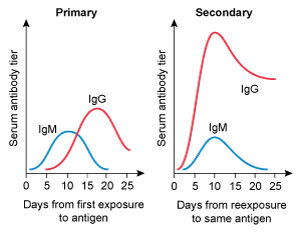 B.
B.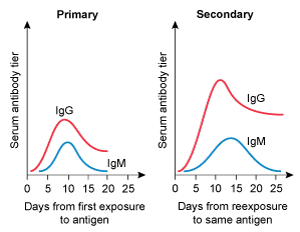 C.
C.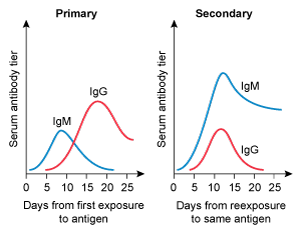 D.
D.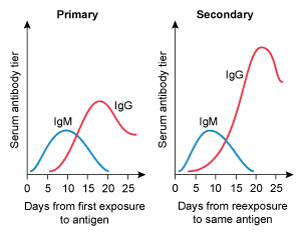 E.
E.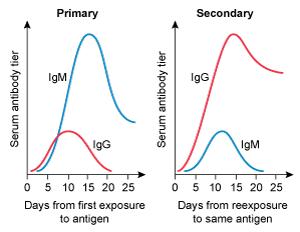 CorrectIncorrect
CorrectIncorrect -
Question 21 of 36
21. Question
An 11-year-old girl is brought to the office for a health maintenance visit. She feels well and has no chronic medical conditions. As part of routine care, the patient receives a first dose of the quadrivalent meningococcal conjugate vaccine and the 9-valent human papillomavirus vaccine. Five minutes later, while being escorted to the waiting area, the patient appears pale and reports feeling dizzy. She immediately loses consciousness, but a fall is prevented by the health care provider. Blood pressure is 70/40 mm Hg and pulse is 46/min. On physical examination, the patient has normal lung and heart sounds. There is no rash. Which of the following is the most likely cause of this patient’s syncope?
CorrectIncorrect -
Question 22 of 36
22. Question
A 5-year-old girl is brought to the office for evaluation of a persistent cough. The patient has had a productive cough daily for the past month. History includes recurrent episodes of otitis media despite bilateral ear tube placement, numerous lower respiratory tract infections, and occasional ulcerative skin lesions. Laboratory evaluation shows normal levels of total B and T cells and serum immunoglobulin. Genetic testing reveals a mutation in the TAP1 gene, which encodes a protein involved in the transport of cytosolic molecules into the endoplasmic reticulum. Which of the following processes is most likely to be impaired by this mutation?
CorrectIncorrect -
Question 23 of 36
23. Question
A 24-year-old, previously healthy woman is evaluated for skin rash, joint pains, and renal failure. She is found to have decreased C3 and C4 levels and a normal factor B level. Which of the following most likely triggered the complement system activation in this patient?
CorrectIncorrect -
Question 24 of 36
24. Question
Pharmacology researchers are developing a new antivenom to treat coral snakebites. They immunize horses with snake venom, extract IgG-containing plasma, and then administer the plasma to humans who have been bitten by a coral snake. This therapy neutralizes the venom and improves the patient’s symptoms. In order to produce venom-selective antibodies, the researchers select a single venom-specific plasma cell from the immunized horse and induce it to proliferate and produce large amounts of venom-specific IgG. However, they find that the antibody produced by the single plasma cell is less effective at neutralizing the venom than the IgG-containing plasma. A decrease in which of the following best explains the reduced efficacy of the immunoglobulin produced by the single plasma cell?
CorrectIncorrect -
Question 25 of 36
25. Question
A 26-year-old man returns to the emergency department after developing a fever and skin rash. The patient was discharged from the hospital 10 days ago after treatment for a copperhead snake bite to his left leg. He received multiple doses of polyvalent Fab antivenom therapy and other supportive care during hospitalization. The patient’s bite site pain, swelling, and ecchymosis have resolved; however, he has developed fever, pain in multiple extremity joints, and pruritic rash over the past 2 days. He has no chronic medical conditions. Temperature is 38.5 C (101.3 F), blood pressure is 128/70 mm Hg, pulse is 98/min, and respirations are 17/min. Physical examination shows a diffuse urticarial rash. No mucous membrane lesions are present. There is tenderness to palpation of the bilateral metacarpophalangeal joints, wrists, and ankles with no redness or swelling. Blood cell counts, serum chemistry studies, and coagulation parameters are within normal limits. Which of the following is the most likely underlying mechanism of this patient’s current condition?
CorrectIncorrect -
Question 26 of 36
26. Question
A 2-year-old boy is brought to the emergency department due to 4 days of worsening cough and fevers. This evening, the patient developed increasingly rapid breathing. He has a history of 2 prior episodes of cervical lymphadenitis due to Staphylococcus aureus. Temperature is 39 C (102.2 F). Blood pressure is 100/72 mm Hg, pulse is 130/min, and respirations are 35/min. Prominent intercostal and supraclavicular retractions are present. There are diffuse crackles bilaterally, with decreased breath sounds at the lung bases. Heart sounds are normal. The patient is intubated. Laboratory results are as follows:
Complete blood count
Hemoglobin
11.8 g/dL
Platelets
280,000/mm3
Leukocytes
15,000/mm3
Neutrophils
64%
Bands
11%
Lymphocytes
25%
Bronchioalveolar lavage fluid tests positive for Aspergillus fumigatus. Serum immunoglobulin levels are normal. Which of the following is the most likely underlying cause of this patient’s presentation?
CorrectIncorrect -
Question 27 of 36
27. Question
A 65-year-old woman is enrolled in a clinical trial to test a new medication for rheumatoid arthritis. The patient’s condition has been poorly controlled despite prolonged treatment with multiple disease-modifying antirheumatic drugs. The new medication is a CTLA4-Ig fusion protein that prevents CD28 from binding to CD80/86 on antigen-presenting cells. A month after treatment begins, the patient reports a significant reduction in joint pain and stiffness. Laboratory results reveal reduced levels of C-reactive protein and IL-2. Which of the following is the most likely underlying cause of this patient’s treatment response?
CorrectIncorrect -
Question 28 of 36
28. Question
A 6-year-old boy is being evaluated in the office due to a history of recurrent infections and failure to thrive. He has been hospitalized for pneumococcal pneumonia twice and has had 5 episodes of otitis media. The patient also has a history of prolonged diarrhea caused by Giardia intestinalis. Physical examination shows a lack of tonsillar tissue, as well as minimally palpable cervical, axillary, and inguinal lymph nodes. Further evaluation shows that the patient has defective signaling between activated CD4 T cells and B cells. Which of the following laboratory findings are most likely to be found in this patient?
 CorrectIncorrect
CorrectIncorrect -
Question 29 of 36
29. Question
A 15-month-old boy is brought to the emergency department due to fever and foot swelling. The patient first developed swelling of the right foot and fever 4 days ago. Today, swelling of the left foot also developed. Medical history is significant for a perianal abscess at 9 months of age. Imaging studies reveal osteomyelitis affecting the metatarsal bones of both feet. Intravenous antimicrobials are administered, but the patient still has fever and bilateral foot swelling 2 weeks later. Laboratory workup shows persistent neutrophilic leukocytosis. Bone biopsy culture grows Staphylococcus aureus. Evaluation for an underlying diagnosis is initiated; via use of a rhodamine derivative, the patient’s peripheral blood is stimulated with phorbol myristate acetate (PMA) and compared with a control. Results of the test are shown in the image below:

Which of the following processes is most likely impaired in this patient?
CorrectIncorrect -
Question 30 of 36
30. Question
A 24-year-old nurse comes to the office for his annual wellness visit that includes tuberculosis screening. The patient has no chronic medical conditions and does not have recent fever, cough, or other health changes. He receives an intradermal injection of tuberculin on the inner surface of his forearm. Two days later, he has a distinct area of induration 20 mm across at the injection site. Which of the following interactions is essential to the development of this patient’s skin reaction?
CorrectIncorrect -
Question 31 of 36
31. Question
A 9-year-old girl is brought to the office due to persistent nasal drainage. Over the past 2 weeks, the patient has had increasing nasal congestion and drainage. The discharge was initially clear but has become dark and foul smelling over the past few days. The patient has a history of multiple skin abscesses that developed when she was an infant, but they typically do not cause discomfort. She has also had atopic dermatitis since infancy. Temperature is 37.1 C (98.8 F). On examination, the patient is interactive and talkative. Thick nasal discharge appears from both nares. Cardiopulmonary examination is normal. There are several diffuse areas of dry, excoriated skin along the trunk and upper extremities. Results of a complete blood count are as follows:
Hemoglobin
11 g/dL
Platelets
200,000/mm3
Leukocytes
7,500/mm3
Which of the following patterns of immunoglobulin production is most likely to be seen in this patient?
 CorrectIncorrect
CorrectIncorrect -
Question 32 of 36
32. Question
Researchers are developing a vaccine to protect against a novel coronavirus infection. The virus spreads via droplet inhalation and enters respiratory epithelium using viral spike proteins. The researchers develop mRNA for the spike protein in vitro and formulate an mRNA vaccine that can be administered to susceptible individuals. The protective effect generated by this vaccine most likely involves which of the following mechanisms?
CorrectIncorrect -
Question 33 of 36
33. Question
A 48-year-old woman is evaluated for a painless left breast mass. Physical examination shows a 4-cm mass with dimpling of the overlying skin; left axillary lymphadenopathy also is noted. Breast imaging reveals a spiculated soft tissue mass with microcalcifications. Biopsy of the mass demonstrates invasive ductal carcinoma. Immunohistochemistry of the tissue sample shows the tumor cells are negative for estrogen and progesterone receptors but overexpress the HER2 epidermal growth factor receptor. The patient is treated with systemic chemotherapy and a monoclonal antibody drug that binds the extracellular domain of the growth factor receptor. Repeat evaluation 6 weeks later shows a decrease in the size of the breast mass. Which of the following host factors are primarily responsible for mediating the response to the monoclonal antibody therapy?
CorrectIncorrect -
Question 34 of 36
34. Question
A 7-year-old boy is brought to the clinic by his parents after developing red urine earlier in the day. The patient has asthma, allergic rhinitis, and atopic dermatitis. He was recently treated for a skin infection. Blood pressure is 140/90 mm Hg. On physical examination, there is periorbital edema as well as pitting edema on both feet. Laboratory results are as follows:
Serum chemistry
Blood urea nitrogen
14 mg/dL
Creatinine
1.4 mg/dL
Which of the following is most likely responsible for this patient’s renal injury?
CorrectIncorrect -
Question 35 of 36
35. Question
Researchers are investigating the use of immune checkpoint inhibitors for the treatment of advanced colorectal cancer. They find that this therapy is more effective in patients with DNA mismatch-repair deficiency compared to patients with an intact mismatch-repair mechanism. Which of the following most likely explains the improved efficacy of the drug in the first group of patients?
CorrectIncorrect -
Question 36 of 36
36. Question
A 75-year-old man is hospitalized due to respiratory distress. The patient developed fever, cough, and muscle aches 4 days prior to admission. He is otherwise healthy and has no chronic medical conditions. The patient has received all recommended vaccinations, including a yearly flu vaccine. Temperature is 39 C (102.2 F), blood pressure is 110/65 mm Hg, pulse is 115/min, and respirations are 29/min. Chest x-ray shows bilateral infiltrates. Reverse transcriptase PCR of a specimen from a nasopharyngeal swab reveals a strain of influenza A virus that was included in the seasonal trivalent flu vaccine. The patient lives with his 50-year-old son, who received the same vaccine but did not develop the infection. Which of the following factors most likely increased this patient’s risk of vaccine failure compared with that of his son?
CorrectIncorrect
